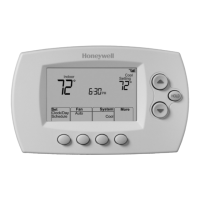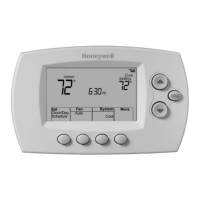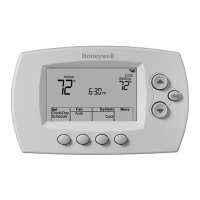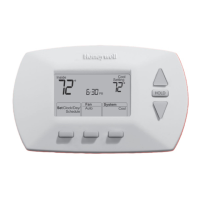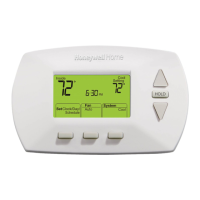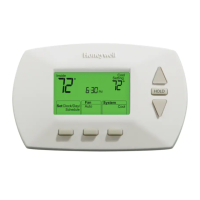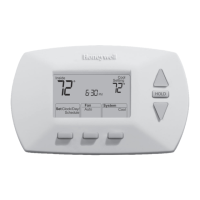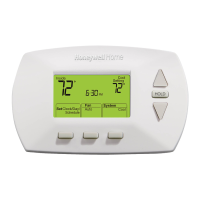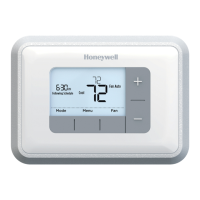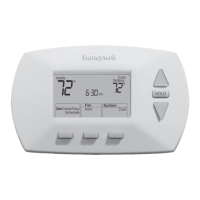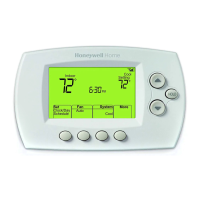
Do you have a question about the Honeywell RTH6500WF and is the answer not in the manual?
| Wi-Fi Connectivity | Yes |
|---|---|
| Programmable | Yes |
| Works with Amazon Alexa | Yes |
| Energy Star Certified | No |
| Stages | 1 Heat/1 Cool |
| Programmability | 7-day |
| Type | Smart Thermostat |
| Connectivity | Wi-Fi |
| Temperature Range | 40°F to 90°F (4°C to 32°C) |
| Geofencing | Yes |
| Compatibility | Most heating and cooling systems |
| App Control | Yes |
| Voice Control | Yes (Amazon Alexa, Google Assistant) |
| Energy Saving Features | Yes |
| Power Source | Battery (AA) or C-Wire |
Identifies the product as a Wi-Fi enabled programmable thermostat.
Specifies the model series of the thermostat.
Details compatible heating/cooling systems and systems the thermostat will not work with.
Advises on mercury disposal and compressor protection to prevent damage.
Outlines what users can do, such as remote control and receiving alerts.
Lists key features like Smart Response Technology and compressor protection.
Explains the thermostat's main display elements and icons.
Details the purpose of each button for operating the thermostat.
Outlines the three main steps for setting up the thermostat.
Lists the tools needed for installing the thermostat.
Instructs to turn off power to the heating/cooling system before installation.
Guides on removing the old thermostat and documenting wire connections.
Emphasizes the necessity of a C wire for thermostat power.
Details how to label wires using provided tags according to terminal designations.
Instructs on removing the old wallplate after wires are disconnected.
Explains how to detach the thermostat unit from its wallplate.
Guides on securely mounting the new wallplate to the wall.
Reaffirms the critical role of the C wire for thermostat operation.
Introduces wiring considerations for conventional and heat pump systems.
Provides step-by-step instructions for wiring to a conventional HVAC system.
Provides instructions for wiring to a heat pump HVAC system.
Details alternate wiring configurations for conventional systems when labels don't match.
Explains the specific connections for the conventional system's alternate wiring.
Details alternate wiring configurations for heat pump systems when labels don't match.
Explains the specific connections for the heat pump system's alternate wiring.
Guides on inserting the quick reference card into the thermostat.
Instructs on securely attaching the thermostat unit to the installed wallplate.
Details how to safely turn the heating/cooling system back on.
Guides on setting the current time and day of the week.
Explains how to identify and set the correct heating/cooling system type.
Guides on testing the thermostat to ensure proper heating/cooling operation.
Lists the necessary wireless devices for connecting to the Wi-Fi network.
Details how to connect a wireless device to the thermostat's temporary network.
Guides on connecting the thermostat to the user's home wireless network.
Provides solutions if the home Wi-Fi network is not found.
Explains how to verify a successful Wi-Fi connection and registration status.
Instructs on navigating to the Total Connect Comfort website to begin registration.
Guides on creating a new account or logging into an existing one.
Details how to enter the thermostat's unique MAC ID and MAC CRC for registration.
Confirms successful thermostat registration with a success message on screen.
Notes signal strength display and availability of the Total Connect Comfort mobile app.
Step-by-step guide to set the current time on the thermostat.
Instructions for selecting the current day of the week.
Explains the 'Auto' and 'On' settings for the thermostat's fan.
Describes the available system modes: Heat, Cool, Off, Auto, and Em Heat.
Guides on programming wake, leave, return, and sleep periods with temperatures.
Explains how to change the temperature temporarily until the next scheduled period.
Details how to use the HOLD function for a permanent temperature adjustment.
Instructions for re-connecting the thermostat if the Wi-Fi router is replaced.
Guides on disabling the Wi-Fi feature on the thermostat.
Describes how the thermostat learns system response times to reach set temperatures.
Explains the feature that prevents compressor short-cycling to protect equipment.
Describes how the thermostat automatically switches between heating and cooling based on temperature.
Introduces the system functions that can be configured on the thermostat.
Step-by-step instructions for navigating and changing thermostat functions.
Crucial setting to match the thermostat to the specific heating/cooling system.
Configuration for heat pump systems regarding the O/B terminal.
Setting to control how the fan operates during heating.
Settings related to the efficiency and stages of heating cycles.
Configures the thermostat's automatic switching between heating and cooling.
Enables or disables the Smart Response learning feature.
Sets the display format for temperature to Fahrenheit or Celsius.
Controls whether the programmable schedule is active or disabled.
Allows assigning a name to the thermostat for remote identification.
Controls the Wi-Fi connectivity status of the thermostat.
Indicates whether the thermostat is currently connected to a Wi-Fi network.
Options to restore default schedules or original factory settings.
Addresses common questions about Wi-Fi connectivity and router passwords.
Answers questions about finding MAC IDs and resolving registration problems.
Covers issues with account login and methods to improve Wi-Fi signal strength.
Provides steps to diagnose and resolve a lost Wi-Fi signal indicator.
Explains specific error codes related to router power and Wi-Fi password.
Details error codes for IP address issues, no internet, and general errors.
Addresses problems with a blank display or inability to change system settings.
Troubleshoots fan not turning on and compressor protection messages.
Helps diagnose issues with heat pumps in wrong modes and unresponsive systems.
Solves problems like heating running in cool mode or simultaneous operation.
Provides definitions for key terms like C wire, MAC ID, and QR Code.
Details FCC compliance statements, warnings, and interference information.
Covers RF exposure limits and Industry Canada regulations.
Outlines the terms, conditions, and limitations of the product's warranty.
